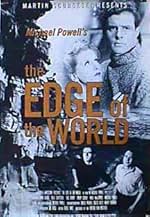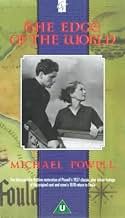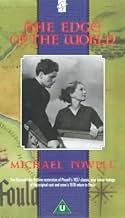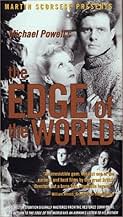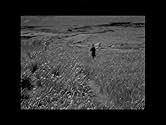NOTE IMDb
7,3/10
2,3 k
MA NOTE
Ajouter une intrigue dans votre langueA way of life is dying on a remote Scottish island, but some of the inhabitants resist evacuating to the mainland.A way of life is dying on a remote Scottish island, but some of the inhabitants resist evacuating to the mainland.A way of life is dying on a remote Scottish island, but some of the inhabitants resist evacuating to the mainland.
- Réalisation
- Scénario
- Casting principal
- Récompenses
- 1 victoire et 1 nomination au total
Niall MacGinnis
- The Gray Family: Andrew, His Son
- (as Niall Macginnis)
Andy Gear
- Villager in Evacuation
- (non crédité)
Mima Gear
- Villager in Evacuation
- (non crédité)
Wullie Gear
- Fiddler at Hirta Reel
- (non crédité)
Aggie Jean Gray
- Member of the Congregation
- (non crédité)
Agnes 'Nannie' Gray
- Member of the Congregation
- (non crédité)
Edith Gray
- Member of the Congregation
- (non crédité)
James Andrew Gray
- Member of the Congregation
- (non crédité)
Jean 'Jeannie' Gray
- Member of the Congregation
- (non crédité)
Avis à la une
10jotix100
Michael Powell, the distinguished English director, was a man of vision. He takes us on a voyage to a remote place in order to set his drama about what the inhabitants of the mythical Hirta, in the Hebrides, were going through. The film was actually filmed in Fulla, in the Shetland Islands, which resembles its model. The original island of St. Kilda had been deemed the last place on earth as the Romans sailed the area and since the island resembles a wall rising from the sea, it must have appeared that way to those explorers. Mr. Powell was lucky in working with the producer Joe Rock, whose generosity made this early film worth discovering.
The film opens with a shot of the island from the sea. We see the island rise from the water, as the Romans might have seen it. Little has changed in the place, except now it's deserted. The people of the island have long gone over the mainland because it was hard for them to make a living in that barren and inhospitable place. The island is now a bird sanctuary. The yacht is commandeered by Andrew Gray, who has left the place and now his memories of that turbulent past come back to him.
We go back in a flashback to know what happened in the island some time ago. We see the Manson family as they prepare for church. Peter, the patriarch, has two children, Ruth and Robbie. Andrew Gray is in love with the beautiful Ruth. Later in a competition to get to the top of the highest spot in the island Robbie suffers a tragic accident. Andrew decides to leave for the main land with his father's blessings, but Ruth is left with child, not knowing how to contact Andrew. When the whole population decides to leave, Peter Manson, reluctantly agrees, but tragedy intervenes when a terrible accident occurs.
The acting is magnificent. John Laurie is seen as Peter Manson, the man whose love for the land is his passion. Belle Chrystall plays Ruth the gorgeous island girl in love with Andrew. Eric Berry and Niall MacGinnis are Robbie and Andrew and Finlay Currie makes James Gray come alive.
"The Edge of the World" shows a Michael Powell in great form. Mr. Powell must have taken a tremendous chance by even filming in that remote place, but he is rewarded by a timeless film that will live forever.
The film opens with a shot of the island from the sea. We see the island rise from the water, as the Romans might have seen it. Little has changed in the place, except now it's deserted. The people of the island have long gone over the mainland because it was hard for them to make a living in that barren and inhospitable place. The island is now a bird sanctuary. The yacht is commandeered by Andrew Gray, who has left the place and now his memories of that turbulent past come back to him.
We go back in a flashback to know what happened in the island some time ago. We see the Manson family as they prepare for church. Peter, the patriarch, has two children, Ruth and Robbie. Andrew Gray is in love with the beautiful Ruth. Later in a competition to get to the top of the highest spot in the island Robbie suffers a tragic accident. Andrew decides to leave for the main land with his father's blessings, but Ruth is left with child, not knowing how to contact Andrew. When the whole population decides to leave, Peter Manson, reluctantly agrees, but tragedy intervenes when a terrible accident occurs.
The acting is magnificent. John Laurie is seen as Peter Manson, the man whose love for the land is his passion. Belle Chrystall plays Ruth the gorgeous island girl in love with Andrew. Eric Berry and Niall MacGinnis are Robbie and Andrew and Finlay Currie makes James Gray come alive.
"The Edge of the World" shows a Michael Powell in great form. Mr. Powell must have taken a tremendous chance by even filming in that remote place, but he is rewarded by a timeless film that will live forever.
What's it like to live on a treeless rock in the middle of the roiling north Atlantic. We get a pretty good idea from master film-maker Michael Powell who set up his camera in such a place with a few actors, a scant script, and actual residents as extras. And a heck-of-a movie it is. The result looks like something from the neolithic era, with its crude rock huts, long barren vistas, and a few hunkered-down plants, along with jagged cliffs rising out of the sea like the face of God. One thing for sure -- there's no lack of fresh air .
I can't imagine the movie was made for commercial potential. It resembles Robert Flaherty's gripping documentary of life in the Irish Sea, Man of Aran, which may be why Powell distinguished his effort with a story-line. But the visuals are quite similar. And that's fine, because the craggy vistas are unforgettable. This is close to movie making at its purest and most visual. In fact, on another viewing, I think I'll turn off the sound and simply gasp at the other-world imagery.
The story may be secondary, but it's appropriate. The few remaining islanders are leaving after centuries of habitation because of deteriorating conditions. There's a romantic complication, but thankfully it doesn't get in the way. A few scenes etch themselves in my memory-- the sheep dogs lined-up outside the crude church, the tiny mail-carrying boats tossed into the sea like wishes, but most of all, the overawing sea cliffs, endless in their poetry and power. It's got to be here that the earth meets the sky or whatever it is that's above.
Rather hard for me to believe that this spartan black and white was made by the same artist who made the splashy Technicolors of The Red Shoes and Peeping Tom. But Powell excelled at cinema regardless of format, putting him in the same league as the few other British masters like Alfred Hitchcock. But whatever the pedigree, this 80 minutes of air, rock and water remains a really compelling oddity.
I can't imagine the movie was made for commercial potential. It resembles Robert Flaherty's gripping documentary of life in the Irish Sea, Man of Aran, which may be why Powell distinguished his effort with a story-line. But the visuals are quite similar. And that's fine, because the craggy vistas are unforgettable. This is close to movie making at its purest and most visual. In fact, on another viewing, I think I'll turn off the sound and simply gasp at the other-world imagery.
The story may be secondary, but it's appropriate. The few remaining islanders are leaving after centuries of habitation because of deteriorating conditions. There's a romantic complication, but thankfully it doesn't get in the way. A few scenes etch themselves in my memory-- the sheep dogs lined-up outside the crude church, the tiny mail-carrying boats tossed into the sea like wishes, but most of all, the overawing sea cliffs, endless in their poetry and power. It's got to be here that the earth meets the sky or whatever it is that's above.
Rather hard for me to believe that this spartan black and white was made by the same artist who made the splashy Technicolors of The Red Shoes and Peeping Tom. But Powell excelled at cinema regardless of format, putting him in the same league as the few other British masters like Alfred Hitchcock. But whatever the pedigree, this 80 minutes of air, rock and water remains a really compelling oddity.
If I had to name one of my favourite film directors, a few always come to mind, and they always include Michael Powell. He has made some of the (for me) most fascinating, thrilling, strange, intriguing and often exhilarating movies ever. He has made about 60 films in about 40 years and plenty of them would easily fit into my all time favourite top-10 films: The Red Shoes, Black Narcissus, The Life and Death of Colonel Blimp, Peeping Tom, Gone To Earth, A Canterbury Tale, 49th Parallel, One of Our Aircraft is Missing, A Matter of Life and Death, I Know Where I'm Going, Contraband, A Spy in Black - I can recommend them all as essential viewing if you are interested in English cinema of the 1940s and 1950s. Now the Arts Channel (in New Zealand) decided to screen one I hadn't seen before, The Edge of the World, from 1937. A tragic and powerful tale of an isolated island off the coast of Scotland (in Roman times known as Ultima Thule, the island of Foula standing in for St Kilda) affected by diminishing local resources of fuel and manpower, causing emigration, economic, social and environmental decline. It was fascinating and moving to see the stories of local families intertwined with the larger social and economic issues driving change. A constant recurrence of a cinematic theme throughout the film was gravity, which of course pulls everything down: people and sheep falling off cliffs, the pull of the wider world out there affecting the economic base of the island, fishing, livestock and crofting. The camera angles are fascinating throughout as every scene is filmed either from a upward or downward position, emphasising the will of men to fight for what they want and believe in, or being looked on by the camera acting as mother nature overwhelming the actors by the majestic cliffs, pounding seas and constant winds. You'd wish there could have been another outcome for the people involved but in the end it seems it's not possible to live at the edge of the world: you either choose to leave or die on the island.
It was very strange watching a film that was shot on an Island that I can see out of my living room window (on clear days).
The film touched on many issues that affected people of the Shetlands around that time, but you should glad hearted, because in REAL life the people of Foula (the REAL Island) still managed to survive, there are approx 30 people living on Foula (Pronouced "Fulla") at this time, and they now have (as from the end of 2004), for the first time 24 hour electricity! (previously only 15 hours a days worth).
Of course, none of the main characters are from Shetland, because they sound Scottish. (The Shetland accent is a mix of Scots and Norwegian Dialect), but the film does its best.. and people who lived in Shetland NEVER spoke Scottish Gaelic.. ever.. tho they did speak Danish before the 17th Century...
This film is available in the Shetland Libraries, and it is watched with much mirth by us... watch and enjoy!
The film touched on many issues that affected people of the Shetlands around that time, but you should glad hearted, because in REAL life the people of Foula (the REAL Island) still managed to survive, there are approx 30 people living on Foula (Pronouced "Fulla") at this time, and they now have (as from the end of 2004), for the first time 24 hour electricity! (previously only 15 hours a days worth).
Of course, none of the main characters are from Shetland, because they sound Scottish. (The Shetland accent is a mix of Scots and Norwegian Dialect), but the film does its best.. and people who lived in Shetland NEVER spoke Scottish Gaelic.. ever.. tho they did speak Danish before the 17th Century...
This film is available in the Shetland Libraries, and it is watched with much mirth by us... watch and enjoy!
Odd little film directed by Michael Powell long before his huge success once teamed with Emeric Pressburger.
Subtitled "the death of an island," the film chronicles the dreary lives of island folk as seen in flashback by the former residents years after. Victims of the changing world, commercialized fishing, and isolation, the islanders finally pack it in and move to the mainland after the death of one young man and a near miss with a baby.
Set in an era before electricity and telephones the film shows just how isolated the people are on the various islands north of Scotland. Independent and stubborn, they cling to their rock even though they know the end is coming.
The story is slim: the young people are in crisis of whether to stay and keep the island going or go to the mainland and get good-paying jobs. The story shows us their lives on the island of Hirta (which means death) and the draw of the cities.
Almost shot in documentary form, Powell constantly shows us the majestic beauty of the sparse rock of island versus the drab lives of the people. Their lives are built around church, social interaction, and trying to keep going.
The acting is minimal with a few familiar faces. John Laurie is the hard father who sees his son (Eric Berry) die in a stupid accident while climbing the face of sea rock. Belle Chrystall is Ruth and Niall MacGinnes is Robbie. Finlay Currie co-stars.
The island scenery is just gorgeous and Powell has a good eye for the incredible backdrops of sea and rock and waving grasses.
Subtitled "the death of an island," the film chronicles the dreary lives of island folk as seen in flashback by the former residents years after. Victims of the changing world, commercialized fishing, and isolation, the islanders finally pack it in and move to the mainland after the death of one young man and a near miss with a baby.
Set in an era before electricity and telephones the film shows just how isolated the people are on the various islands north of Scotland. Independent and stubborn, they cling to their rock even though they know the end is coming.
The story is slim: the young people are in crisis of whether to stay and keep the island going or go to the mainland and get good-paying jobs. The story shows us their lives on the island of Hirta (which means death) and the draw of the cities.
Almost shot in documentary form, Powell constantly shows us the majestic beauty of the sparse rock of island versus the drab lives of the people. Their lives are built around church, social interaction, and trying to keep going.
The acting is minimal with a few familiar faces. John Laurie is the hard father who sees his son (Eric Berry) die in a stupid accident while climbing the face of sea rock. Belle Chrystall is Ruth and Niall MacGinnes is Robbie. Finlay Currie co-stars.
The island scenery is just gorgeous and Powell has a good eye for the incredible backdrops of sea and rock and waving grasses.
Le saviez-vous
- AnecdotesIn the scene of the race up the cliffs, the actors did their own climbing. According to director Michael Powell's book on the making of the film, Eric Berry in particular did some risky work indeed, especially in the shots of him clambering up the waterfall.
- GaffesThe wild Golden Eagle at the beginning has the falconer's jesses (leather straps) visible.
- Citations
The Gray Family: Andrew, His Son: Do you think I don't care about Robbie? Do you think I'd forget that he was your twin brother and my best friend?
- Crédits fous[before opening credits] The slow shadow of Death is falling on the outer isles of Scotland. [scrolls up] This is the story of one of them -- and all of them. When the Roman Fleet first sailed round Britain they saw from the Orkneys a distant island, like a blue haze across a hundred miles of sea. They called it - "ULTIMA THULE" [main title] THE EDGE OF THE WORLD
- ConnexionsFeatured in Return to the Edge of the World (1978)
- Bandes originalesChorus
(uncredited)
Composer unknown
Performed by The Glasgow Orpheus Choir
Conducted by Hugh S. Roberton
Meilleurs choix
Connectez-vous pour évaluer et suivre la liste de favoris afin de recevoir des recommandations personnalisées
- How long is The Edge of the World?Alimenté par Alexa
Détails
Box-office
- Budget
- 20 000 £GB (estimé)
- Durée1 heure 21 minutes
- Couleur
- Rapport de forme
- 1.37 : 1
Contribuer à cette page
Suggérer une modification ou ajouter du contenu manquant

Lacune principale
By what name was A l'angle du monde (1937) officially released in India in English?
Répondre
